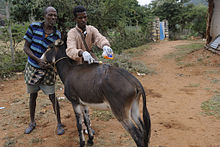

Spring Weather Challenges & Cattle Health Issues
 Posted by SLN Staff on Feb 16th, 2014 | Comments Off on Spring Weather Challenges & Cattle Health Issues
Posted by SLN Staff on Feb 16th, 2014 | Comments Off on Spring Weather Challenges & Cattle Health Issues 

Spring can be a challenging season for cattle. During spring; the sudden changes in weather patterns can have serious effect on cattle, especially on weaned young calves. During the season change, the cattle health can suffer a great deal because their immune systems can be weak and they may become vulnerable to many diseases, parasites and germs due to sudden changes in weather, especially if a snow blizzard or cold rain occurs. Although some breeds of cows like, the Miniature Highlander can withstand the harsh weather, proper health care should still be provided.
During spring, the cattle and calves need to be carefully monitored and taken care of through the use of state-of-the-art cattle equipment. Cattle farmers need to take special disease prevention measures during this time of the year because of the fluctuations in weather. Spring weather can weaken the immune systems of cattle making them vulnerable to viruses, parasites and bacteria. There are several types of diseases that you need to watch out for during spring. We are going to discuss some of the major spring disease below.
Bovine Respiratory Disease (BRD)
 Bovine Respiratory Disease is the major cause of economic losses among the cattle farmers in the U. S. It’s caused by several reasons in combination, on single cause. This disease affects the upper or lower respiratory tracts and can cause pneumonia in weaned calves, lactating or nursing cattle, and housed dairy cows.
Bovine Respiratory Disease is the major cause of economic losses among the cattle farmers in the U. S. It’s caused by several reasons in combination, on single cause. This disease affects the upper or lower respiratory tracts and can cause pneumonia in weaned calves, lactating or nursing cattle, and housed dairy cows.
Prevention of Bovine Respiratory Disease
The best way to prevent this disease is through vaccination, before the stress with Pasteurella vaccine. A long term treatment may be needed if the vaccination is not applied. If the calves were not vaccinated before weaning, shipping or stress, they may be treated with antibiotics. Injecting calves with TETRADURE® 300 (oxytetracycline) may help the young calves to fight BRD.
Coccidiosis
Spring can get wet and muddy and messy, when animals are most susceptible to Coccidiosis. This parasitic disease is caused by coccidian protozoa, and is highly contagious. Coccidiosis spreads from one animal to another through contact of feces or if they ingest infected tissues. Diarrhea, which may often become bloody, is the major symptom of this disease. Although most infected animals do not show symptoms of the disease, young calves may be most vulnerable to coccidiosis. Once animals get sick, they may refuse to eat and start growing weak.
Prevention of coccidiosis
To prevent coccadiosis, farmers need to be watchful especially on your calves that has been weaned or freshly hauled into the farm. Once the symptoms of the disease become apparent, it may be too late. Best approach to preventing coccidiosis is to stay on top of this diesese with a preventive coccidisis program as part of the general health plan for the cattle. Once cattle become sick, it might be too difficult to bring them back to normal, and animals often die from coccadiosis if clinical symptoms appear in animals. CORID® (amprolium) can be used with drinking water. There are also formulas available to go with their feed. Because this disease affects the lining of the stomach, animals might not benefit from feeding, and so extra feed and supplements should be provided to the sick animals. It is also advisable to reduce animal stress.
 Fluctuating spring weather can be an extra stress for the cattle especially for the young calves. If you do not know the medical history of freshly brought animals, it is better to treat them and use vaccination for all major diseases. Regular feeding of added nutritious diet and fodder supplements may also be needed because animals need extra energy to deal with the fluctuating weather. A good fodder system can help them overcome the stress more easily during the messy spring seasons, when a cold rain or snow blizzard may add to the extra stress of animals.
Fluctuating spring weather can be an extra stress for the cattle especially for the young calves. If you do not know the medical history of freshly brought animals, it is better to treat them and use vaccination for all major diseases. Regular feeding of added nutritious diet and fodder supplements may also be needed because animals need extra energy to deal with the fluctuating weather. A good fodder system can help them overcome the stress more easily during the messy spring seasons, when a cold rain or snow blizzard may add to the extra stress of animals.






